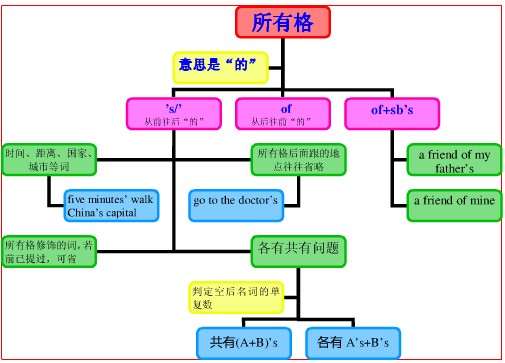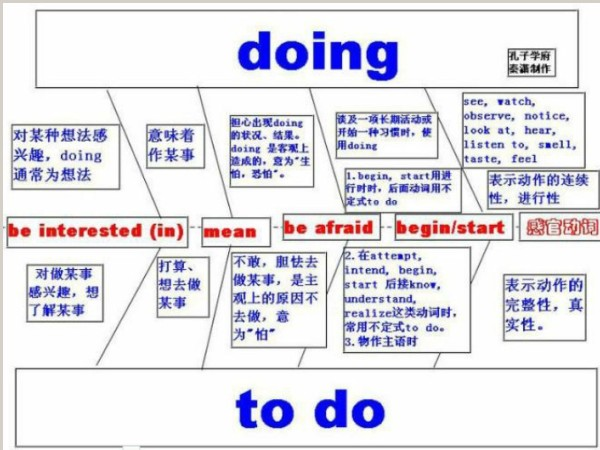本试题 “________ to pass the 2010 college entrance examination made our whole family unhappy.[ ]A.My son failedB.My son's failingC.My son failingD.My s...” 主要考查您对名词所有格
动名词
等考点的理解。关于这些考点您可以点击下面的选项卡查看详细档案。
- 名词所有格
- 动名词
名词的格的种类:
在句中表示所有关系的语法形式称为名词所有格。
例如:Tom's best friend is Mary. (Tom's 是所有格,Mary为通格)
The title of the book is interesting. (of the book为所有格)
-'s所有格的用法:
-'s所有格主要用于有生命的东西,但有时也可用于无生命的东西,这主要见于:
(1)用于表时间的名词后:
tomorrow's weather 明天的天气
two days' journey两天的旅程比较:
ten minutes' break=a ten-minute break 10分钟的休息
(2)用于表国家、城市的名词后:America's policy 美国的政策 the city's population 这个城市的人口
(3)用于某些集合名词后:the majority's view 多数人的观点 the government's policy 政府的政策
(4)用于组织机构后:the station's waiting-room 车站候车室 the newspaper's editorial policy 这家报纸的编辑方针
(5)用于度量衡及价值名词后:a mile's distance1 英里的距离 twenty dollar's value 20美元的价值
注:对于带有连字符已转化为形容词的度量衡,不能用所有格形式:ten-minute walk 10分钟的路程 (比较:ten minutes' walk)
(6)用于表天体的名词后:the moon's rays 月光 the earth's surface 地球表面
(7)用于某些固定表达中:a stone's throw 一箭之遥 at one's wit's end 黔驴技穷 at arm's length 以一臂之距 out of harm's way 在完全的地方
注:名词所有格并不一定表示所有关系,有时可能表示其他意义:
(1)表类别:a doctor's degree 博士学位,Children's hospital 儿童医院
(2)表动作执行者:Mr Smith's arrival 史密斯先生的到达
(3)表动作承受者:Children's education 儿童教育
-'s所有格与of所有格的用法比较:
(1)of 所有格既可用于有生命的人或物,也可用于无生命的东西。of 所有格有时可以与-'s所有格互换。如:
Mr Smith's son=the son of Mr Smith 史密斯先生的儿子
Jim's patience=the patience of Jim 吉姆的耐心
the Queen's arrival=the arrival of the Queen 女王的到达
(2)必须用's所有格的情形:
①表类别时:men's shoes男鞋,Children's stories儿童故事
②表来源时:John's telegram 约翰的电报
③当被修饰的名词后有同位语修饰时:
Mary's husband, a policeman, has just been here. 玛丽的丈夫是个警察,刚刚来过这儿。
(3)必须用of 所有格的情形:
①用于无生命的事物时:the subject of the sentence 句子主语
②表同位关系时:the City of Beijing 北京市
③当中心词是名词化的名词时:the life of the poor 穷人的生活
④当of 所有格中的名词后跟有后置修饰语或同位语时:
Mr Smith is a foreign teacher of a university in China.史密斯先生是中国一所大学的外籍教师。
-'s所有格的构成方法:
(1)一般情况(包括单数名词和不带词尾s的复数名词)加-'s:Children's books儿童图书 today's paper今天的报纸
(2)带词尾s的复数名词只加省字撇( ' ):girls' school女子学校 the Smiths'car 史密斯家的小汽车
注:带词尾s的单数名词,通常仍加's:the boss's plan 老板的计划 the hostess's worry女主人的担心
(3)带词尾s的人名,可加's或只加省字撇( ' ):Dickens' novels 狄更斯的小说 Charles's job查理斯的工作。
不带词尾-s却以咝音结尾者,一律加's:Marx's works 马克思的著作 George's room 乔治的房间
(4)用and连接的并列连词的所有格要分两种情况,即表示各自的所有关系时,要分别在并列连词后加-'s,表示共同的所有关系时,只在最后一个名词后加-'s:
Tom's and Jim's rooms 汤姆和吉姆(各自)的房间
Tom and Jim's rooms 汤姆和吉姆(共同)的房间
名词所有格知识体系:

双重所有格的使用:
(1)所谓双重所有格就是指将“-'s”所有格与of 所有格结合起来一起使用: a friend of my father's 我父亲的一位朋友 a photo of Mr Smith's 史密斯先生的一张照片
(2)双重所有格的使用场合:
①当被修饰名词前有指示代词、疑问代词、不定代词或数词等限定词时,一般要用双重所有格:
如:I don't like that big nose of David's. 我不喜欢大卫的那个大鼻子。
Which novel of Dickens' are your eferring to? 你谈的是狄更斯的哪部小说?
Some friends of my brother's wil lcome. 我兄弟的一些朋友要来。
注:被双重所有格修饰名词前有指示代词时,通常带有一定的感情色彩(如赞赏或厌恶等)。
如:That little daughter of your cousin's is really a dear. 你表哥的那个小女儿真是逗人爱。(表赞赏)
That daughter of your cousin's is constantly complaining.你表哥的那个女儿老是在报怨。(表厌恶)
另外,被双重所有格修饰的名词前可以用不定冠词,但通常不用定冠词:
可以说:a poem of Shelly's, a novel o fDickens'
不能说:the poem of Shelly's, the novel of Dickens'
②有时既可用双重所有格也可用of 所有格,但含义稍有差别。
比较:a photo of Mary's 玛丽收藏的一张照片
a photo of Mary 玛丽照的一张照片
a criticism of William's 威谦提出的批评
a criticism of William 对威谦的批评
动名词概念:
动名词是一种兼有动词和名词特征的非限定动词。它可以支配宾语,也能被副词修饰,动名词有时态和语态的变化。
现在分词和动名词用法比较:
动词的-ing形式包括现在分词和动名词两种形式。他们的句法功能如下:
动词的-ing形式如果作句子的主语或者宾语时,应该是动名词形式;如果作补语或者状语时,应该是现在分词形式。那么作表语或者定语的动名词和现在分词又该怎样区分呢?
1、动名词与现在分词作表语时的比较:
(1)动名词作表语说明主语的内容,回答what的问题;现在分词作表语相当于形容词作表语,说明主语的性质、特征等,回答how的问题。
如:One of the best exercises is swimming. 游泳是最好的运动项目之一。
What pleases him most is bathing in the sea. 最使他高兴的事是在海中沐浴。
The situation both at home and abroad is very in-spiring. 国内外的形势都很鼓舞人心。
The color is pleasing to the eye. 颜色悦目。
(2)动名词作表语,表语和主语几乎处于同等地位,可以互换位置,其句意不变;现在分词作表语,表语和主语则不能互换位置。
如:Our work is serving the people.
(=Serving the people is our work.)我们的工作是为人民服务。
The news was disappointing. 那消息令人失望。
(3)作表语的现在分词前可以用very,quite,rather,greatly等副词修饰,而动名词则不可以。
如:What he said was very encouraging. 他的话很鼓舞人心。
Our goal is realizing the four modernizations in the near future. 我们的目标是在不久的将来实现四个现代化。
(4)现在分词与形容词一样可以和more,the most构成形容词的比较级和最高级,而动名词则不可以。
如:The story is the most fascinating. 那个故事最迷人。
(5)作表语用的现在分词除了和be连用以外,还可以和其它的系动词连用;而作表语的动名词则通常只能和be连用。
如:His speech seems inspiring.他的演讲似乎很鼓舞人心。
His interest is writing for the news papers. 他的爱好是给报社写文章。
(6)有些用作表语的现在分词已经形容词化了。常见的有:exciting,moving,inspiring,missing,interesting,disappointing等。
2、动名词与现在分词作定语时的比较:
(1)动名词作定语时,表示它所修饰的名词的性能和用途,和它所修饰的名词在逻辑上没有主谓关系;
现在分词作定语时,表示它所修饰的名词正在进行的动作,和它所修饰的名词在逻辑上有主谓关系,常可以扩展成一个定语从句。
如:a swimming girl=a girl who is swimming 一个在游泳的姑娘
a walking stick=a stick that is used for walking 一根拐杖
(2)现在分词作定语有时可以后置,而动名词则通常只能放在它所修饰的名词之前。
如:The girl wearing glasses is one of his students. 戴眼镜的那个女孩是他的一个学生。
I bought some reading materials. 我买了一些阅读材料。
动名词的用法:
1、作主语:
例如:Fighting broke out between the South and the North. 南方与北方开战了。
2、作宾语:
a. 有些动词可以用动名词作宾语。
例如:admit承认 appreciate感激 avoid避免 complete完成 consider认为 delay耽误 deny否认 detest讨厌 endure忍受 enjoy喜欢 escape逃脱 fancy想象 finish完成 imagine想象 mind介意 miss想念 postpone推迟 practice训练 recall回忆 resent讨厌 resume继续 resist抵抗 risk冒险 suggest建议 face面对 include包括 stand忍受 understand理解 forgive宽恕 keep继续
例如:Would you mind turning down your radio a little, please? 你把收音机音量调小一点,好吗?
The squirrel was lucky that it just missed being caught. 这松鼠幸运得很,刚逃避了被逮住的厄运。
b. 有些结构后面可以用动名词作宾语或其他成分。
例如:admit to prefer...to burst out keep on insist on count on set about put off be good at take up give up be successful in be used to lead to devote oneself to object to stick to no good no use be fond of look forward to be proud of be busy can't help be tired of be capable of be afraid of think of
3、作表语,对主语说明、解释:
例如:Her job is washing, cleaning and taking care of the children. 她的工作是洗刷、清扫和照顾孩子。
比较:She is washing, cleaning and taking care of the children.
4、作定语,一般表示所修饰名词事物的用途:
例如:a writing desk=a desk for writing 写字台
a swimming pool=a pool swimming 游泳池
有些动名词作定语,与所修饰的名词关系比较复杂。
例如:boiling point=a temperature point at which something begins to boil 沸点
a walking tractor=a tractor which a driver can operate while he or she is walking behind it 手扶拖拉机
动名词知识体系:

动名词与不定式用法对比:

与“________ to pass the 2010 college entrance examination ma...”考查相似的试题有:
- 22. The Interactional Red Cross is______non-profit organization that cares for the wounded, sick and homeless in wart...
- It is re ported that the United States uses _____ energy as the whole of Europe. A.as twiceB.twice muchC.twice muc...
- Of the 2,000 stock investors______ last month, 90% was found ________ in financial knowledge.[ ]A. surveyed; lackingB...
- I will appreciate ______ if you can give me a hand.A.thisB.thatC.itD.one
- — Haven't I told you that the computer needs _____?— Sorry, I forgot _____ it fixed. I'll send it for repair right aw...
- It is so cold in the room. Would you mind me _____ the door?[ ]A. closeB. to closeC. closingD. closed
- Section C (12 points)Directions: Complete the following passage by using ONE word that fits the context.Shopping habi...
- 短文改错。以下标有题号的每一行均有一个错误,请找出,并按下列情况改正:此行多一词:把多余的词用斜线(\)划掉,在该行...
- Though a typhoon is on the way, people are still looking forward ________ the outdoor concert by thepop singer.[ ]A....
- He insisted that he______ his best and ______ rewarded.A.had done, must beB.did, must beC.do, should beD.had done...